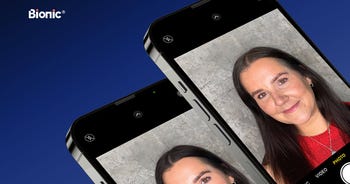What is the Internet of Things? Everything your business needs to know
Sometimes a piece of tech comes along that sounds more complicated than it really is. Voice over Internet Protocol (VoIP), for example, is just a technical name for an Internet phone line.
But it works the other way too, and something as complex as a network of physical objects that are embedded with sensors and other tech so they can communicate in real time is called the Internet of...’Things’.
Here’s all you need to know about the Internet of Things (or ‘IoT’ to its friends) and how you can use it for your business.

What is the Internet of Things?
The Internet of Things (IoT) is the name given to a network of objects that are connected by, and can communicate over, an internet connection. The ‘things’ in question could be anything from kitchen appliances and televisions to security cameras and healthcare monitors.
The idea is that these items collect and share data to improve efficiency and create a better user experience.
Take buying printer ink as an example. It’s one of those things that you don’t know you’re short of until it’s too late. A system like HP Instant Ink removes the risk of this happening by monitoring your printer usage and sending out new ink when you start running low.
As with any connected technologies, there are privacy and security concerns - anything that is connected to the internet can be hacked – so we’ll pick that back up later on. But first, let’s take a closer look at how it actually works.
How does the Internet of Things work?
Connected devices are fitted with sensors and processors and connect to the network using WiFi or Bluetooth. The sensors then collect data about the device, including how and when it’s used, and the processor analyses the data to inform any decisions (like whether you need more printer ink).
Cloud technology means devices can also communicate with one another. Let’s say you’re a salon owner with a smart thermostat at your workplace. This will be connected to your business WiFi and linked to other devices like your smartphone.
If you’re away from the workplace, you can use your smartphone to adjust the thermostat, but an IoT-enabled thermostat can even take this simple task off your hands. If the thermostat has sensors that can detect room temperature, humidity, and whether there are people in the salon, it can use this information to adjust the settings or to even turn it off completely.
Over time it should be able to learn your preferences over time to optimise energy usage.
How big is the Internet of Things?
It’s hard to say how big the Internet of Things is – estimates for the number of IoT devices worldwide range from between 11 billion to 50 billion, depending on the source. Either way, there are billions of connected devices across the globe, and figures are expected to triple over the next decade.
What are examples of IoT devices?
There are broadly two main sectors where IoT devices are used:
- Health and major industry – Health monitoring, farming equipment, water supply and waste management, manufacturing, transportation and storage.
- Consumer market – Internet and media devices, including smartphones, televisions, and wireless Internet.
Here are some examples of common IoT devices.
Connected cars
There are loads of ways that cars are connected to the Internet of Things, from dashcams to infotainment systems, to the vehicle’s onboard computer (OBC).
These devices then collect data from things like the accelerator, fuel tank, and speedometer to monitor driver performance as well as the health and condition of the vehicle.
This technology can send automatic alerts if a vehicle is in a crash or even help to pre-empt issues with components before they break down. It can also help haulage and rental car firms to track their fleets and monitor driver performance.
Smart cities
IoT technology is being used by governments and local councils for all sorts of town planning and infrastructure projects, ranging from measuring air quality to parking management systems. Smart systems are also being used to automate lighting systems to cut usage and save money, as well as to detect maintenance needs for roads, pipelines, and other infrastructure.
Smart buildings
Using IoT technology can help cut energy usage in commercial buildings. A network of sensors, controllers, and automation systems work together to manage various building systems, including lighting, heating, ventilation, air conditioning, security, and access control. This means lights and heating can automatically be turned on and off depending on how many people are in the building.
What is the Industrial Internet of Things?
The Industrial Internet of Things (IIoT) is the name given to the use of integrated smart devices, machines, and sensors in industrial and manufacturing settings. Devices communicate, exchange data, and perform automated tasks to help improve efficiency, productivity, and safety.
What are examples of IIoT?
There are loads of ways the Industrial Internet of Things is improving safety and efficiency in commercial settings. Here are some examples from different sectors.
Manufacturing
Remote monitoring helps manufacturers track performance and identify issues. Predictive maintenance means manufacturers can use sensors and data analytics to predict when machinery is likely to fail. Together, these systems can help improve efficiency while preventing costly downtime and unplanned maintenance.
Retail
Smart shelves use sensors to track inventory levels, detect when products are low, and automatically reorder stock. When used with sensors that track items as they move through the supply chain, this can help retailers to automate stock audits and ordering.
Automated checkout systems use sensors, cameras, and machine learning algorithms to identify and track products as they are added to a shopping cart. Customers can then pay for their items using a mobile app, reducing the need for staffed checkout lanes.
Logistics and transport
Smart fleet management sensors can be integrated with vehicles to collect and analyse data in real time. This can help drivers find the best routes to save time and cut fuel consumption. Systems can be integrated with warehouse operations to help with inventory management and improve efficiency when picking and packing goods.
What are the benefits of IoT?
Internet of Things technology has the potential to transform the way we live and work. Here are some of the ways in which it could be used to improve efficiency, cost savings, and more.
- Improved efficiency - IoT devices can help automate and streamline various tasks, leading to improved efficiency in different industries.
- Cost savings - By using IoT technology to monitor and manage resources, businesses can optimise operations and reduce waste, leading to significant cost savings.
- Enhanced customer experience - IoT devices can help businesses gather data on customer behaviour and preferences, allowing them to provide a more personalised experience.
- Remote monitoring - IoT devices can be used to remotely monitor equipment and systems, allowing for quick identification and resolution of issues.
- Improved safety and security - IoT devices can be used to monitor and control access to buildings, vehicles, and other physical assets, improving safety and security.
- Predictive maintenance - IoT devices can monitor equipment performance in real time, allowing for predictive maintenance and reducing downtime.
- Energy efficiency - IoT devices can be used to optimise energy consumption, leading to significant energy savings.
- Improved health and wellness - IoT devices can be used to monitor health metrics such as heart rate, blood pressure, and physical activity, leading to improved health and wellness outcomes.
What are the disadvantages of IoT?
Although there are loads of benefits, the Internet of Things isn’t without its downsides. Here are some of the potential disadvantages of embracing IoT tech.
- Security risks and privacy issues - IoT devices can be vulnerable to hacking as they don’t have the same internet security systems as our phones and laptops. This can lead to privacy breaches, data theft, and other cyber threats. There are also concerns about how data is collected, stored, and used, which can lead to privacy breaches and other issues.
- Complexity and compatibility issues - IoT systems can be complex, and the integration of different devices can be tricky. This can lead to compatibility issues that can limit the ability to scale and make it difficult to maintain and troubleshoot the system.
- Dependence on connectivity - IoT devices rely on network connectivity to function properly, and any disruptions in connectivity can lead to system failure or downtime.
- Cost - IoT devices and systems can be expensive, and the cost of implementation and maintenance can be prohibitive.
- Data overload - IoT devices generate a lot of data, which can be overwhelming and difficult to manage. This can lead to information overload and make it challenging to extract meaningful insights.
Who owns the Internet of Things data?
Ownership of data gathered by the Internet of Things is a tricky issue that depends on the type of data that was collected, how it was collected, and the terms of the agreement between those involved. This means it could be owned by anyone from the device manufacturer, service provider, or the device user.
But the ownership of data is only part of the issue, as there’s then the question of how the data is used and who owns the rights to the insights gained from it.
Data ownership may be defined in the terms of service or licensing agreements between the parties involved. If you’ve got a smart home device, for example, you might own the data the terms and conditions of use may mean you agree to share that data with the device manufacturer or service provider in exchange for certain features or benefits.
In this instance, it’s unlikely that you’ll have control over how the data or the insights gained from it are used.
On the other hand, ownership may be subject to legal regulations and privacy laws that govern the collection, use, and sharing of personal data. For instance, General Data Protection Regulation (GDPR) provides individuals in the EU and the UK with certain rights over their personal data, including the right to access, delete, and transfer it.
Where is the data stored?
The storage location of Internet of Things (IoT) data depends on things like the type of device, the amount of data generated, and the specific use case.
In some cases, IoT data may be stored locally on the device itself, using internal storage or external memory cards. In other cases, data may be transmitted to a cloud-based storage solution for processing and analysis.
There are also edge computing solutions that store IoT data at the edge of the network, closer to the devices generating the data, to cut the time it takes to send and receive data, as well as improve performance.
How to improve efficiency at your business
The Internet of Things could help efficiency at your business by automating certain tasks. It could even help cut the cost of your energy bills by taking control of heating and lighting systems. And one call to the tech-enabled team at Bionic could also help you save time and cut costs when sorting your business essentials.
We can compare business gas and business electricity deals to help you lock in your rates and protect against price rises. We can also search for deals on business phone and broadband, business insurance, and find business loans to help with anything from cash flow to growth plans.
We can also get you set up with a VoIP phone system to help prepare your business for the 2025 analogue switch-off. Give our tech-enabled team a call on 0808 253 7514 to find out more.








